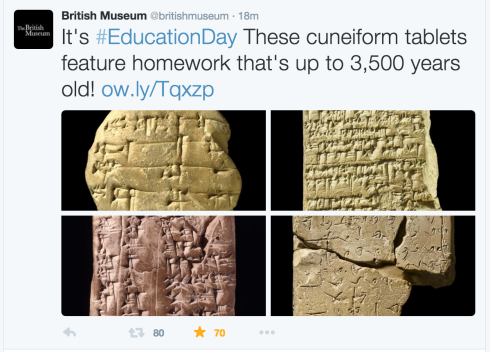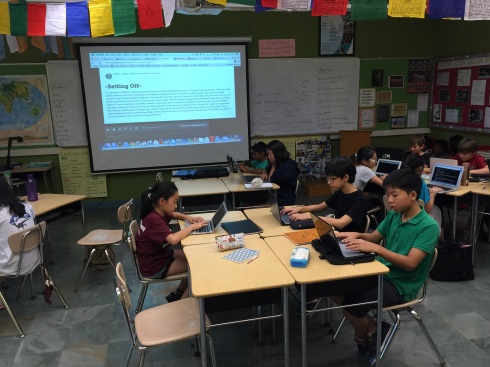Archive | October, 2015
Hammurabi’s Code of Law
27 OctWe are currently learning about Hammurabi’s Code of Law. Here is some information:
The Code of Hammurabi refers to a set of rules or laws enacted by the Babylonian King Hammurabi (reign 1792-1750 B.C.). The code governed the people living in his fast-growing empire. By the time of Hammurabi’s death, his empire included much of modern-day Iraq, extending up from the Persian (Arabian) Gulf along the Tigris and Euphrates rivers.
The code is best known from a stele made of black diorite, more than seven feet (2.25 meters) tall, that is now in the Louvre Museum in Paris. The stele was found at the site of Susa, in modern-day Iran, by excavators who were led by Jacques de Morgan at the beginning of the 20th century. Scholars believe that it was brought to Susa in the 12th century B.C. by an Elamite ruler who subsequently erased a portion of it in preparation for creating an inscription of his own.- (from Live Science)
Why are laws necessary? What basic ideas about the law did Hammurabi’s Code set up?
Here is an interesting article that a student shared with me last year – 8 Things You May Not Know About Hammurabi’s Code.
Rubber legs in the Caucasus
21 Oct
Paul has started his walk! He left Tbilisi and is heading to the Caspian Sea. Click on any of these maps to make them bigger.
Great Quotes
19 OctI saw this quote on Instagram today, and it made me think about the Out of Eden Learn project, and the goals – looking beyond what’s in front of you and noticing new details in your neighborhoods as you make your maps. In class you are watching Paul walk with a group of students from Georgia. Watch how he models slow journalism and teaches students to look for small details. India is an amazing place with so much history and culture. Try new things, meet new people.
Creation of a Written Language – Cuneiform
17 Oct
Theo Van Den Hout, a professor of Hittite and Anatolian Languages, tells us about scribes in Mesopotamia and Anatolia. This short video was made for the Oriental Institute Museum special exhibit “Visible Language: Inventions of Writing in the Ancient Middle East.” In Chapter 3, you learned about scribes, the people who specialized in writing, the stylus, which is the instrument they used to write on clay tablets, and cuneiform, the wedge-shaped writing. Read more about the development of writing and pictograms on the British Museum’s website on Mesopotamia. Why do some historians identify the beginning of history with the beginning of writing? Tell me an interesting fact or two you learned about writing in Mesopotamia from one or more of these videos.
On the Trail with Paul & Tips to Help You
17 Oct
Students,
This video is one of Paul walking with a group of students in the country of Georgia. He teaches them how to slow down and notice things in their neighborhoods. You will find this helpful as you work on all of your “Footsteps” for Out of Eden Learn. Here are are some tips:
-
Notice 10 things about your neighborhood as you walk (or use the See -Think-Wonder routine we do)
-
Use your senses as you notice things – seeing, touching, etc.
-
You really need to look for things you might not have noticed before. You are not going to do that if you do not go outside and explore.
Footstep #2 – Neighborhood Map
14 OctThis week we launch Footstep #2 in our Out of Eden Learn project. Students will learn what a “milestone” is in the Out of Eden Walk, and they can look at some of Paul’s milestones during his journey in part #1 in Footstep #2. The first project for Footstep #2 is to create a neighborhood map and to write a story about your neighborhood or the area where you live.
Directions for the project will be shared in class and they will be posted on our Moodle page by tomorrow. The due dates and expectations, along with a rubric are in on the document in Moodle. Please look at some of the examples from other students in our walking party. They may be a helpful model as you prepare your map ands story. Remember to write the rough draft of your story on your Out of Eden Learn Google Document. I found a link to old photos of Chennai (Madras) on this link. Check out the pictures, old maps, and art.
Achievements of the Sumerians
14 OctThis playlist features video clips that review the legacy and achievements of Mesopotamia. They are a good review of things we have learned in class. Essential Questions to consider:
1) What new tools did the Sumerians invent?
2) Why was the invention of cuneiform (writing) an important development?
If you like legos, you might find the first two videos creative and humorous.
A Personal Message from Paul Salopek, Twitter Chat questions answered, and More…
8 OctStudents,
We are finishing our first footstep this week, and you all have a good understanding of the purpose of Out of Eden Learn and how the platform works. Today was a really great day and it ended on an even greater note when I received a message from Mr. Salopek saying:
“Your class is one of the most active in the OOEL program, and I am deeply gratified that the walk has found an echo among your students. Their work is astonishing–the photo gray that I’ve seen of a woman’s hands crafting a floral crown seem almost professional quality. Kudos to you and your students. Thanks again for walking along.”
The photo that Paul refers to in his message that seems “almost professional quality” is from Kennedy, a student of mine from last year. It is an amazing photo by a very talented girl. I am confident that you will also produce great maps, take beautiful photos, and learn much about Chennai, India while sharing things about your own culture.
It filled me with great pride when I received this message, and it made me think about the great work my students did last year and the great work you are doing during this first footstep. The next footsteps will get really exciting, as you get to create some cool projects, while sharing your work with other students in our walking party.
Last night, I joined a Twitter ‘chat’ or online discussion with Paul (currently in the country of Georgia) and other people around the world. I asked him some questions on behalf of our class. His answer can be found above my question (My Twitter ‘handle’ is @DigitalNomadRob). Twitter, the the way, has a 140 character limit, so you need to keep questions and replies brief. I have only done one other Twitter Chat, so this was exciting and something new for me as far as social media goes. Here are screenshots of his responses:
Another way you can engage with or follow Paul’s journey is through his excellent blog, Out of Eden Walk, where he posts dispatches (messages). I have added a direct link here, but I also have an RSS feed on the right side of our blog, so you can see updates from him. Read his stories there; if you want, post questions or comments as well. Please understand that he cannot answer everyone’s question or respond to everyone’s comment. In other forms of social media, he is on Twitter, Facebook, and Instagram, and you can find videos and other information on Out of Eden’s Youtube channel and some great Milestone or Glimpse videos on Vimeo.
“Sole Brothers” – Out of Eden Learn (G/H)
5 OctThis week we launched our first “footstep” for the Out of Eden Learn Project. Students watched videos to learn more about Paul Salopek’s journey following the path of human migration. They learned about ‘slow journalism’ and his reasons for taking this trip.G/H block students read Paul’s blog post Sole Brothers. Think about these questions and comment. Our first ‘footstep’ and Part 1 (Get Inspired) is a practice one and it asks you to engage in Paul’s journey and to respond to these questions:
1) What caught your attention or interested you about Paul’s article (Sole Brothers)? Here is an EAL-friendly version.
2) What questions or wonders do you now have (about this article or Paul’s journey)?
Comment below and copy and paste your message to your Out of Eden Learn Google Document (Footstep #1, Part 1) Also, reflect on the beginning of Paul’s story:
“Footwear is a hallmark of modern identity. How best to glimpse an individual’s core values at the start of the 21st century? Look down at their feet—not into their eyes.”
3) What can you learn about someone, or their values from their footwear (see photos of grade 6 footwear)?
In Ethiopia, many people where wear the inexpensive sandals that Paul noticed. Check out the poll question below and vote.
Your Out of Eden Walking Party
3 OctStudents,
This week we will complete our first ‘footstep’ for Out of Eden Learn. Click on the maps above to see who is in your walking party. I have also created a Google Map showing your party.
B/D Walking Party #564 – United States (Buffalo Grove, Illinois; Miami, Florida; Saco, Maine; Danville, California; Marblehead, Massachusetts), Riyadh, Saudi Arabia; Accra, Ghana; Burlington, Ontario, Canada, Bandung, Indonesia
G/H Walking Party #565 – United States (West Hartford, Connecticut; Durham, North Carolina; Kamuela, Hawaii; Danville, California; Anchorage, Alaska; Saddle River, New Jersey; Buffalo Grove, Illinois; Marblehead, Massachusetts), Dar Es Salaam, Tanzania, Accra, Ghana
Class Connection: Choking Haze in SE Asia
3 OctA satellite image released this week by NASA shows the extent of haze currently blanketing much of Southeast Asia. The photo captures plumes of smoke emerging from fires burning in the peatlands of Sumatra and Indonesian Borneo. The smoke blows west into what looks like thick clouds over both islands as well as neighboring Singapore and Malaysia. Choking haze is causing widespread hospitalizations, interfering with transportation, and inflaming political tensions between Indonesia and Singapore.
In class we learned about the slash and burn agriculture. Read this story to see about the modern-day effects on this type of farming in countries that are close to where we live. Here are 5 Things to Know About the Haze.
Class Connection: River from the Sky
3 Oct


































Recent Comments